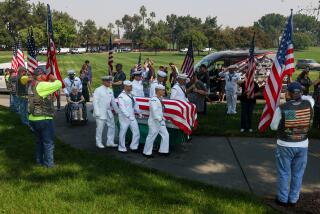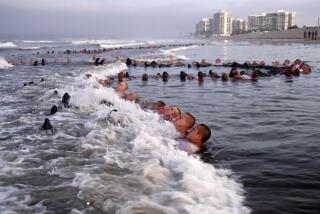Iowa Sailor Seen as Lonely, Troubled : 4-Month Navy Inquiry Finds Hartwig Capable of Suicide
WASHINGTON — Gunner’s Mate Clayton M. Hartwig, who almost certainly caused the calamitous April 19 explosion aboard the battleship Iowa, was a lonely, suicidal young sailor consumed by destructive fantasies, Navy officials have concluded after a four-month investigation.
Hartwig was “emotionally capable of committing suicide, probably with the intent of killing others also,” Vice Adm. J. S. Donnell III said after reviewing the exhaustive Navy and FBI inquiry into the explosion that killed 47.
An FBI personality profile went further, concluding that “Clayton Hartwig died as a result of his own actions, staging his death in such a fashion that he hoped it would appear to be an accident.”
Outwardly Normal
The Navy’s 1,100-page investigation report offers a riveting, disturbing and in some cases, contradictory, picture of a handsome, outwardly normal sailor whom the FBI characterized as a “troubled young man” who was “emotionally devastated” by the real and perceived rejections of those he befriended and loved.
Hartwig, it was learned during the four-month inquiry, had tried to kill himself while in high school, considered himself an expert in explosives and detonators, kept a scrapbook on ship disasters and owned a handbook that offered explicit prescriptions for exacting violent revenge on one’s enemies. He carried a gun in his car and his room at home was filled with military knives and books on war.
Investigators reconstructed the disaster through physical evidence, interviews with survivors and a painstaking review of Hartwig’s letters, belongings and comments to fellow sailors, friends and family. They concluded that the blast was the result of an “intentional, wrongful act” that could only have been committed by one person--the 24-year-old Hartwig.
On the eve of the explosion, Hartwig had been rebuffed by a fellow sailor with whom he tried to initiate a “close relationship,” investigators said.
Discussed Suicide
Naval investigators found that Hartwig had discussed suicide in the weeks before the catastrophe, noting that his preferred way to die was in an explosion. On one visit home, he told a friend that “if something were to happen to the gun powder (in a 16-inch gun turret), the explosion would be quick and there would be no one left to tell the story.”
But while officials pointed an accusing finger at Hartwig, the Navy also found numerous failures of training, discipline, gunnery procedures and maintenance aboard the Iowa. The report recommended possible administrative punishment for several key officers, including the ship’s skipper, Capt. Fred P. Moosally, and its executive officer, Cmdr. John P. Morse.
But while one reviewer of the report cited “the number and egregiousness” of the ship’s shortcomings, the investigators concluded that none of them caused the explosion.
After being briefed by Navy officials on the findings of the investigation, Hartwig’s family called a press conference in Cleveland to assail the report.
“My brother . . . was not a depressed, despondent, suicidal murderer,” Hartwig’s sister, Kathleen M. Kubicina said. “They have no physical evidence, and they used the word ‘probably’ in the report. After months of investigation, and after spending $5 million, they are going to tell the American public ‘probably?’ ”
The family’s lawyer, Kreig Brusnahan, said that the Navy began its investigation by trying to look for a scapegoat to avoid admitting incompetence.
“The Navy is trying to dupe the American public,” he said. “Why didn’t he (Clayton) slit his wrists? Why didn’t he jump off the ship? Why would he take 46 of his closest friends with him?”
Some shipmates and friends drew a different portrait. One Iowa crew member who befriended Hartwig in the two weeks before the fatal blast said that Hartwig was fascinated by death and often talked of how he would prefer to die.
“We both agreed that explosion would be the best way to die because it was quick and painless,” the sailor told agents of the Naval Investigative Service.
Hartwig also confided in this sailor, four days before the fatal blast, that he had attempted suicide and that he was still considering it. “He told me he was having problems, but wouldn’t exactly state what his problems were,” the sailor told investigators.
The two stayed up well past midnight talking two or three nights before April 19. On several occasions, Hartwig discussed explosives and how primers can set off the bags of powder used to fire the 16-inch guns.
“He told me he wanted to die in the line of duty and be buried in Arlington Cemetery, so he’d be remembered,” the sailor recalled.
A girl Hartwig met in 1987 and who corresponded briefly with him described him as “very shy, very self-conscious and lonely.” She said that while he was confident in his ability to do his job aboard ship, he had a hard time making friends and had “very little self-esteem.”
Another civilian friend characterized Hartwig as a “quiet and self-defeating individual.”
His fascination with war and weapons began in Hartwig’s childhood, according to testimony from family and friends. He would closet himself for hours in his attic bedroom, reading military books and watching war movies.
As a boy, investigators learned, Hartwig had blown up tree stumps with homemade explosives.
When NIS agents searched his room at his parents’ home in Cleveland, they found photographs of Hartwig in a Navy commander’s uniform and wearing a special warfare insignia, neither of which he was authorized to wear.
Hartwig subscribed to Soldier of Fortune magazine and signed up as an associate member of an organization of veterans of a special forces unit in Vietnam. He expressed regret that he had not served in Vietnam because he missed the opportunity to serve and kill in combat.
He told some of his fellow sailors that he wanted to join the Navy’s elite Seal frogman team but couldn’t because he did not know how to swim.
Navy investigators spoke with 11 witnesses who attested to Hartwig’s “professional delusions.”
Brags in Letter
Hartwig, for instance, told friends that the April 19 firing would be his last before being transferred to London to become an undercover security agent. He bragged in letters home that he’d be wearing “three-piece European suits” and would be involved in “James Bond-type work.”
The Navy said it had issued no such orders for Hartwig.
One sailor interviewed by NIS agents “volunteered that whenever Hartwig discussed killing, he talked in terms of extreme violence with total annihilation and mutilation.”
Another Iowa sailor said that Hartwig was very interested in “improvised explosives,” and had showed him how to make pipe bombs and other explosives from shotgun shells and trip wire devices.
In preparing and presenting its report, the Navy treated the subject of Hartwig’s rumored homosexuality very gingerly. The Navy’s official findings make no mention of his sexual preference, although NIS agents spent hundreds of hours interviewing sailors and civilian friends trying to determine whether Hartwig was gay.
Dozens of interviewees expressed belief that Hartwig and several of his friends aboard ship were homosexual, and there are numerous references in the interviews to Hartwig being taunted as a “faggot.”
But the report did absolve Gunner’s Mate Kendall L. Truitt of any responsibility. An early theory held that a homosexual relationship between Hartwig and Truitt--a relationship that Truitt has consistently denied--played a role in the tragedy.
The report noted that Truitt did not have access to the gun barrel during the critical few moments when the detonator would have had to have been loaded, the Navy concluded. Nor could Truitt have been certain to survive such a devastating blast, even if he had engineered it, the investigators said.
Says He Was Teased
A sailor who had known Hartwig on earlier Iowa cruises said Hartwig often discussed suicide, particularly after he had been teased about being a homosexual.
Hartwig had been disciplined in 1987 after being caught wrestling with another sailor in front of one of the gun turrets. The incident helped fuel Hartwig’s reputation aboard ship as a homosexual.
One former Iowa crew member, himself gay, told investigators that Hartwig had confided to him that he was homosexual and did not enjoy serving aboard the Iowa because he was ostracized by most of the other sailors.
Hartwig also told this sailor, referring to the battleship, that he wanted to “blow it up.”
‘Death and Destruction’
One former crewman said, “Everything (Hartwig) did, everything he said, it always led back down to the bottom line of death and destruction.”
In spite of the report’s findings on Hartwig, the Navy said it does not plan to strengthen personality screening procedures, Adm. Leon A. Edney, vice chief of naval operations, said.
“As we looked at this situation, we didn’t see anything that required a drastic change or even any predominant change,” Edney added. “The individual looked like a clean-cut sailor. He was a clean-cut sailor. He was a bright sailor. He didn’t smoke, he didn’t drink and he didn’t carouse on liberty. He did his job.”
More to Read
Sign up for Essential California
The most important California stories and recommendations in your inbox every morning.
You may occasionally receive promotional content from the Los Angeles Times.











